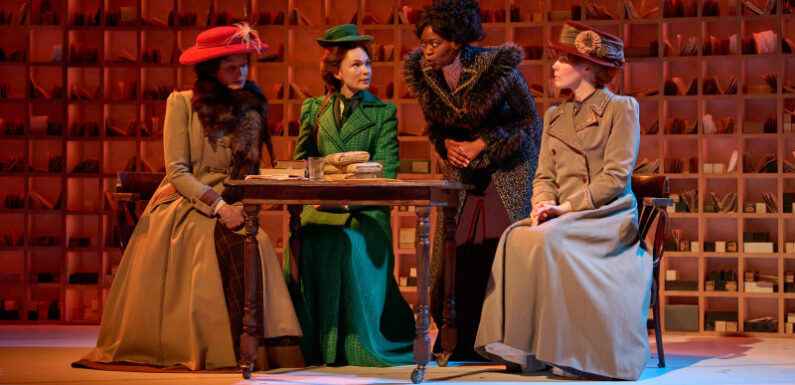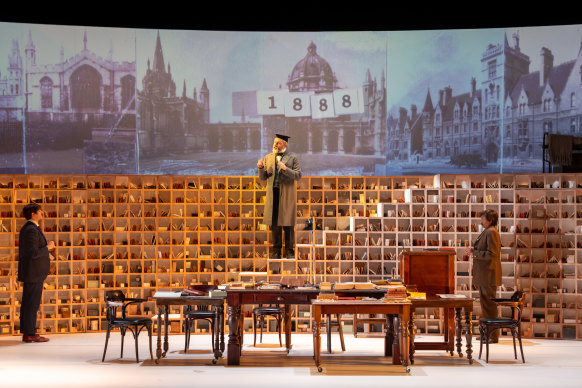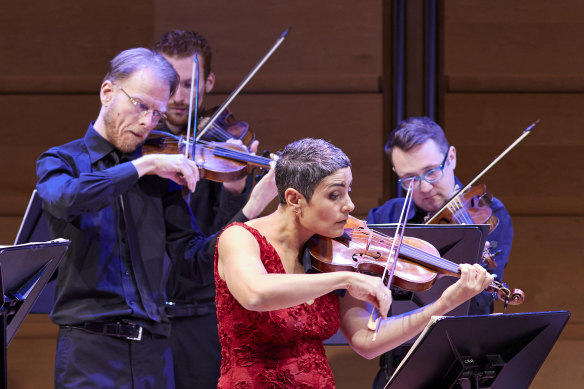
Save articles for later
Add articles to your saved list and come back to them any time.
The Dictionary of Lost Words
Drama Theatre, Sydney Opera House, October 28
Until December 16
★★★½
The Dictionary of Lost Words brings Pip Williams’ best-selling novel to the stage of Sydney Theatre Company, via an adaptation by Verity Laughton, directed by Jessica Arthur. It tells of Esme Nicolls, who grows up playing at her father’s feet in the “scrippy”, the scriptorium, where a dedicated team of lexicographers is compiling the Oxford English Dictionary.
The set, created by Jonathon Oxlade, is central to the story and is almost a work of art in itself.Credit: Daniel Boud
From Esme’s earliest days her world is shaped by the use and meaning of words. But soon she notices words that don’t appear in the dictionary; words used on the street that describe the invisible world of manual labour, sex work and childbirth. Collecting these words becomes her way to make sense of a rapidly changing world.
The first act plays out as a series of vignettes, rattling through Esme’s childhood. It’s slightly laborious: many details beg to be filed away for later in the story, but we are not sure how or why they are significant.
The regional accents and muddy dialogue do not help. In the second act, as the passage of time slows and we focus on the unconventional and passionate woman that Esme has become, the play draws us in.
The set, created by Jonathon Oxlade, is central to this expansive story. The simple wall of pigeonholes, each containing various packages, is arranged with such delicacy it is almost a work of art in itself.
Above is a secondary stage whose back wall becomes a screen, used to help us navigate the rapid passing of time and place. Taken together it is an embodiment of the Dictionary, and of history itself: tiny details contributing to a grand narrative.
While the busy cast of eight jumps in and out of many different characters Tilda Cobham-Hervey, as Esme, is on stage almost throughout. She is extraordinary, transforming before our eyes from a child to a woman. She is beautifully supported by Rachel Burke as Lizzie Lester and Angela Mahlatjie as Tilda Taylor.
There is a moment towards the end that might just encapsulate the immense ambition of the entire enterprise. Esme wants to take the hand that is being offered by her soon-to-be lover, Gareth (Raj Labade) but must first share with him her colourful past.
The confession takes the form of an intricate fast-forward pantomime of what we’ve already witnessed, a flash of vivid memories playing out. Twenty years unfold in as many seconds – the chance meetings, paths not taken, choices made by a woman living through the everyday revolutions of the beginning of the twentieth-century.
Social history. Language. Change. It’s bewildering and exhilarating and happening all around us.
Poet of the Violin
Leila Schayegh, Australian Brandenburg Orchestra
City Recital Hall, October 28
Also November 1 and 3
Reviewed by PETER McCALLUM
★★
Guest leader and violin soloist Leila Schayegh played Jean-Marie Leclair’s Violin Concerto in E minor, Opus 10 No. 5 with a veiled tone – notably dark in lower notes and momentarily flashing like a fine silken thread catching the light in the high register.
Leclair’s style of Baroque virtuosity declines ostentation and emphasises fine elegance rather than the driven energy of his Italian contemporaries (best known today through the music of Vivaldi). The music is lively and inventive but with a hint of insouciant detachment.
Leila Schayegh played the Leclair concerto with a veiled tone – notably dark in lower notes.Credit: Keith Saunders
The greatest rewards in this performance came in the combinations with the strings of the Australian Brandenburg led by Shaun Lee-Chen. The outer movements were nimble but the double-stopped textures seemed designed for a more intimate space and Schayegh’s intonation was shaky at times.
This was even more of a problem in Bach’s Violin Concerto in D minor, a reconstruction from the same composer’s Harpsichord Concerto in D minor of the presumed original violin work, now lost, of which the harpsichord concerto is thought to be an arrangement. Here the violin tone struggled to cut through in the slow movement and in the outer movements the intonation was not at the standard of professional performance.
To start, Schayegh led the orchestra in a curiously named overture by Czech-born Baroque composer Jan Zelenka, Hipocondrie a 7 Concertanti, the title apparently implying nervous disorders in the eighteenth century rather than imagined illness.
Here, under Schayegh’s direction, the orchestral players emphasised drawn sustained notes and well-shaped phrases, rather than their customary spiky articulation, which brings crispness but which can be overdone. The balance, however, was a little thick and unvaried.
Handel’s Concerto Grosso in F major featured an elegant cadenza from Baroque oboist Emma Black and a smooth blend of Baroque bassoon and violas in the final minuet. Some of the most engaged orchestral playing of the concert came in the overture to the final work, Bach’s Orchestral Suite No. 4 in D.
In the Bourrées the wind instruments were less clear than they had been in the Handel but the Menuets and final movement Réjouissance flowed gracefully. This program had promised interesting discoveries but delivered surprising failings.
The Booklist is a weekly newsletter for book lovers from books editor Jason Steger. Get it delivered every Friday.
Most Viewed in Culture
From our partners
Source: Read Full Article

